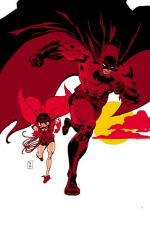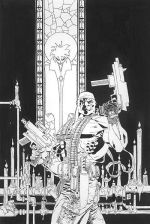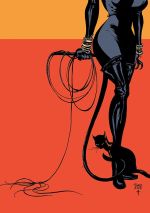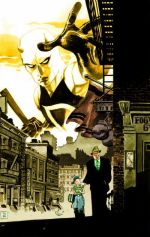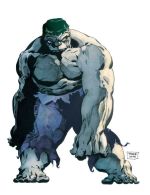“If somebody said to me tomorrow, lets do an illustrated Robin Hood, I’d be right on it”. Tim Sale on how he would like to swap the mean streets of Gotham for Sherwood Forest.
Tim Sale always knew he wanted to be an artist and with a strong interest in fantasy and a certain Cimmerian King, the world of fantasy illustration’s gain might well have been the comic industry’s loss.
With an initial passion to become an inker Tim’s first published comic work was in a ‘try-out’ section of Marvel Age Magazine, however it was years later, in a strip called Thieves’ World that Tim’s first published pencil and ink work appeared. This led to his first work with writer Jeph Loeb on DC Comics Challengers of The Unknown, forging a partnership that would become one of the strongest and most celebrated in comics.
Blades in Legends of the Dark Knight led to a high profile job on Wildstorm’s Deathblow penciling Brandon Choi’s script and following Jim Lee at the height of the Image Comics ‘boom’, then came Wolverine / Gambit for Marvel, again teaming with Loeb. However it was not until 1998’s Batman: The Long Halloween that the creative dynamic duo received the recognition and acclaim that they had been so deserving of.
A noir-esque tale set early in Batman’s career, The Long Halloween tapped into Frank Miller’s Year One and was commissioned by the late, great Archie Goodwin. A murder mystery the story bought Gotham’s criminal underworld to the forefront of the story Long Halloween also featuring Batman’s classic villains and emphasized the partnership between Gordon, Batman and DA Harvey Dent, that bought an emotional core to the book. Batman Begins actor Christian Bale has even gone on record as having turned to Long Halloween whenever he wanted inspiration for his portrayal of the Dark Knight.
Superman For All Seasons followed, with Loeb at the top of his game writing a Superman story from the points of view of Superman’s supporting cast as Sale drew upon Norman Rockwell for his vision for Smallville, a vision that has been cited by the makers of the upcoming movie Superman Returns as being hugely influential.
Then came the Marvel ‘colour’ books, with Daredevil: Yellow, Spider-Man: Blue and Hulk: Grey, each tale told as a ‘love-letter’ to a lost loved one told during a specific era in each characters’ history.
Most recently in 2005 Sale and Loeb returned to DC and told the story of Catwoman’s quest to learn about her mysterious past, in Catwoman: When In Rome.
With long time collaborator Jeph Loeb, having recently signed exclusivity to Marvel Comics and Tim having signed to cross-town rivals DC Comics, he is now at a turning point in his career.
From his California home Tim Sale took time out to Russ Sheath about his career, past, present and future.
Tim, how’s it going?
Well, it seems like a transitional time for me, It’s the first time in a long time I will not be working with Jeph consistently and that does feel strange both emotionally and work wise, but life goes on.
Going forward, I’m very excited about the work that I am doing and I know Jeph is as well and there have certainly been transitions in his life over the past year the tendrils of which go back much further. For purposes of clarification for those who may not know, Jeph’s teenage son, Sam, passed away last year from cancer and the ramifications of that are far reaching, some of them are comic related and some of them of course are not. The comic related ones, as pertained to me are that there will be a tribute issue, the 26th issue of Superman / Batman, which is actually a book that Sam Loeb wrote the plot to and he was actually planning on writing the full script to but he passed away before he could finish that.
Everybody that knew him, and there were a considerable amount in the industry, jumped at the chance to do a jam issue, filling out Sam’s script. I am involved in the issue; two pages in the jam part of it, and also Jeph has written a separate story, called Sam’s Story, for me to draw. It’s set in the Superman for All Seasons era, and I did it in the For All Seasons style. It will be coloured by Jose Delarubia, who coloured the SOLO Superman story that Jeph and I did.
It’s a tribute to Sam and is about Superman’s friend in high school whose name is Sam and who died of cancer and the impact that has on Clark and Superman. It’s a very, very sweet story that I’m tremendously proud of and that Jeph should be proud of too. I certainly hold it up next to anything that we have done, if not the best.
What’s in front of me now is a collaboration that is not official yet and I can only tell you a little about it, It’s a collaboration with Darwyn Cooke on a new Superman book which will be a six part arc and I have gotten the script for one and a half issues which I am working away furiously at on.
Will that be a step away, stylistically from Superman: For All Seasons?
I want For All Seasons to have its own look that is unique to it so I am still in the process of finalizing of how I want the Darwyn book to look. Part of my challenge is not letting myself be too influenced by my love of the way Darwyn draws. I’m trying to find my own look, a look that is particular to this series. Working with Jeph, who can’t draw a lick (laughs) it’s no problem. Working with Darwyn I am seduced by the way he draws so it’s a conservative effort to stay the course.
How does your normal working day work?
It changes all the time, but I am defiantly not a 9-5 and I have never been a 9-5 guy. I kinda burned myself out working as much as I did over the past decade, which sounds funny compared to Jack Kirby’s output for instance. Kirby’s is the benchmark we all fail to achieve of five or six penciled pages a day. I have never worked 9-5; I tend to work during the day, up early and to bed early, which is different than a lot of comics people. It’s always been more of an equation of how many pages need to be done by what time. It’s a different kind of discipline and I am not sure how good I am at it, but It’s what I have always done.
At what point in your life did you decide that you wanted to be an artist and was it always going to be in comics?
Well, I never had a moment of decision. It’s my belief that every child draws or paints or is creative somehow, but that most people will leave that be at some point; they get interested in sports or girls or music or something else, they just move on. I never left that behind. I became enamored of Archie comics when I was about 11 and then of Marvel comics when I was 13.
My family moved from the East coast to the West coast of the United States when I was six and my father bought me comic books to read in the car, and at one point I know that I read the second Amazing Spider-Man Annual by Ditko and Stan Lee guest starring Dr Strange. I didn’t recognise that I had a memory of it until I saw a reprint as a teenager and I had the most amazing deja vu and it somehow said if you have this reaction, somehow you should pursue this a little bit.
I carried a pad of paper around with me and I drew all through High School and I sort of figured this is what I would be doing and it took me a long time to get into comics, but I figured that art would be my destiny. One of those things that just seems to be the way things are.
When you were emerging as an artist, was it that you were always going to be a comic book artist?
Well, I thought it was, but I got disillusioned with comics in my twenties, and tried various other forms of illustration, as well as a fair amount of the usual in-your-twenties drifting. I got back interested in the 80’s when Miller and Moore were shaking things up. Dave Sim, Matt Wagner, lots of people were being really differently creative.
One of the things that has been a real source of joy, inspiration and interest in my life since meeting Mark Chiarello, is that he has a great depth of knowledge of American illustration from the twenties to the sixties. Working on Dark Victory with him we became very good friends and talked and shared a mutual interest in various artists. One of the things that has been inspiring to my
comics work is the influence and discovery of great illustrators like Rockwell and Dorne and Fawcett and McGinnis. At some point I would love to do some other things, I have a long standing desire to do children’s books and we will see what ever happens with that.
Which is your one single favourite comic book that signifies for you that’s why I got into comics?
I have an unsatisfying answer in that there isn’t one single book, but I could give you five off the top of my head. Nick Fury Agent of Shield # 1 by Steranko, The Spider-Man Annual # 2. There is an arc of the Fantastic Four, I believe It’s # 84-87 by Lee and Kirby that i love. Silver Surfer # 4 by John and Sal Buscema and Stan Lee. I am a huge fan of the work that Barry Smith dismisses now, his early work which is admittedly derivative of Kirby and Steranko, and I find tremendously exciting
and energetic, interesting compositions and overlapping frames. I remember issue 52 of Daredevil, he penciled it, George Kline is the inker, Roy Thomas wrote it and it guest stars the Black Panther. I thought it was fabulous, pages two and three are divided into horizontal bars, with a dark figure that we think is DD, flipping around the city. Turns out it’s the Black Panther, and to my 13 year old brain it was the coolest thing in the world. Between that and pages two and three of SHIELD #1, to this day I am a big fan of silent sequences.
You spent some time in the UK when growing up, how did that shape your career to come?
Unfortunately all I can say is that it allowed me to cheaply buy American comics. I turned 13 when I first came over to London, and I was deemed old enough and responsible enough to travel the city on my own. Instead of walking around sketching or soaking up the sights all I did was go around a chain of stores called Popular Book Centres and each one of them had, behind the counter, a
stack of American comic books. They sold for sixpence and I greatly expanded my collection there and rightly or wrongly that made me love England (laughs). It was too early for Guinness or bitter but not too early for a steak and kidney pie which I learned to love.
My grandparents lived in New York and I was intimidated by the sky scrapers, but London seem a much more human scale place to be and I was allowed to travel around on my own and you can only imagine the skirts the girls were wearing in 1968. It was a great place to be a 13 year old boy.
You have a more overt artistic sensibility and appreciation of art outside of comics than many of your peers, I cannot think of many other artists who speak of Monet or Gruau, which is almost unique in today industry, how important is it to you that you draw upon those influences?
It is the single reason that I am still working in comics. I think that without the influence and interest in illustration outside of comics, I would have found something else to do. Maybe there are not many people working in the superhero field who are interested in people working outside of it, but there are a few of us! Darwyn, Mark, Adam Hughes, to name a few. I have only just started to scratch the surface. The internet is a great recent source for my illustrator education, there are numerous sites devoted to particularly American illustration of the 20th century. I learned of Gruau through a book that Bud Plant was selling back at the San Diego convention and Mark Chiarello knew of him and said “look at this book” and his artwork continues to be of interest.
On my website, www,timsale1.com, I have a list of influences that range across media.
I’m 50 years old, and most guys working in superhero comics are 30 years younger. I was 30 before I got into comics and I think my work benefits from that I found my influences elsewhere. I think that just a cursory look of the comic racks right now will show that most of the people in comics are really derivative of other comics, they don’t get their inspiration from other artists outside of comics.
The cover of Spider-Man: Blue # 1 is influenced by an artist named Mitchell Hooks; I don’t know if anyone would look at that cover and say “oh look, Tim’s doing Mitchell Hooks”, but I knew what that’s what I was doing.
There is almost an element that you are educating the reader and broadening their horizons and making them think more about not just comic book art, but art in general?
Well the intent is not to educate, but to create an image that is intriguing. What I have in my head is the 20 year old Timmy and who would go into record stores and look at who wrote and produced a record and knowing that and figuring it out from looking at the record label is what I was interested in, and that’s my audience to me. The person who is interested in that kinda thing. Figuring that stuff out, why is he drawing it this way as opposed to that way? What’s the reason behind that? I may not like it but It’s not just an accident, so what is it?
Looking at your book Tim Sale: Black and White, there seems to be a strong fantasy influence, for example the sword and sorcery type stuff and you also mention Barry Smith’s Conan, is there any wish to revisit those archetypes and do a fantasy book?
I have actually just done some Conan drawings, the first Conan drawings I have done of any consequence for 30 years. Barry Smith’s Conan work I have followed and I liked at times and didn’t like at times but there was a period where it was deeply seductive. The fantasy work, before the heavy influence of the pre-Rapaelites. Ultimitely, I suppose, Conan is Frazetta to me! As enormous a fan of Buscema as I am, I’m not at all a fan of his Conan work.
More and more, if I can make it work, I would love to do some Conan. A lot of the older pulp characters are really interesting to me and I would love to find a way in. They don’t have a definitive look in the way Frazetta did with Conan.
There is no definitive Shadow or no definitive Doc Savage and things like that. I am also a big fan of European albums and through them the idea of doing an American western or a private eye story. A lot of that is what I tried to do
with SOLO and have different genres and draw them in different ways and try to be as versatile as I could.
I did a Tolkien Calendar for my sister, Maggie, in the late seventies because I thought that the Tolkien calendars that were being published around the time sucked. The great thing about literature is that there are any number of different interpretations from different people and I would like to partake in that. From when I was a child, any book that put pictures in my head I liked and
adventure fantasy did that more than anything else. Anything that has anything to do with the Robin Hood legend, or Batman or Zorro or anything where you are avenging the weak or where you are the champion of the weak is thrilling to me. If somebody said to me tomorrow, lets do an illustrated Robin Hood, I’d be right on it.
But a lot of the pulp stuff I think is where my future lies, I feel very comfortable with that idea and with that world.
Your comments in your Black and White book don’t come across as your being particularly happy with your work on Deathblow or Wolverine / Gambit, would that be a fair comment?
Yeah! It had nothing to do with the people I was working with or anything like that. It’s just that my heart wasn’t in those characters. Although I was working with Jeph on Wolverine / Gambit I didn’t know those characters. We were in
discussion with the story we wanted to tell but it didn’t end up being that story so it was disappointing in that way, and although the experience of working with Marvel and with Jeph was great it just was unfulfilling because it didn’t have the extra dimensions that Jeph and I hope to bring to something.
On Deathblow it was different, I didn’t know Brandon Choi and I didn’t know Jim Lee and I ended up having a phone relationship with the colourist and it wasn’t the same kind of collaboration I was used to having with Jeph. In addition I was asked to imitate Jim imitating Frank Miller and that always felt kind of weird, yet kind of fun. All of that joy was taken away when it turned out Frank Miller was upset with that, which was a total surprise as I had been lead to believe he was cool with it. It wasn’t a hugely fulfilling job and it was a very strange time in comics. Image was coming back to earth and in certain respects and I may have helped them come back to earth in that I wasn’t selling a billion comics for them, a fact for which I apologise (laughs). Everybody was perfectly nice and everybody was accommodating and I was paid well and all of that was great but I was soured on that more than on Wolverine / Gambit because of Frank Miller’s comments.
Tell us about the Marvel colour books?
All of the Marvel colour books came out of my influence by Marvel comics of the 60s. Spider-Man was my favourite character growing up and I loved what Ditko did but ten times more I loved what Romita did. The particular arc of Spider-Man 44-49 was what we were drawing upon (in Spider-Man: Blue) and is part of what made me fall in love with comics. What I was trying to do was a 60s New York look, a sort of pop art, John Romita look. I was in love with New York city and the things I could do with the ink wash.
With Daredevil: Yellow, Jeph wrote this tremendous romantic comedy, but my favourite experience of the marvel books was the very minimal Hulk: Grey. The whole six issues takes place in twenty four hours out in the desert most of the time, dealing with a couple of people. For Betty, Daddy is a monster so she falls in love with a real monster. What the hell is Betty doing being attracted to this guy? Well, look at daddy. It’s a brilliant psychological way of looking at it and Jeph was the first guy to put
that together.
The plan was there was going to be four arcs, and it’s entirely my fault that there wasn’t because my work rate went down and the fourth was always supposed to be Captain America, and it may very well be Captain America at some point in the future, I would love for it to be. It’s set in WWII and will follow the template of the other three books in that it’s framed in a love letter to a lost
loved one and that Bucky is the lost loved one. Captain America is never able to escape his guilt for bringing this boy into a war. It’s very emotional and very exciting and I would need to find a way to make it mine. Noel Sickel, Jack Davis, Harvey Kurtzman, Joe Kubert, their war stories and depictions of war stories are prominent and somewhere in that range, I would try to find my way. There is a Joe Kubert Enemy Ace book where he collaborates with Neil Adams. Enemy Ace is a WW I German fighter pilot, very moral and of aristocratic birth whose everyday job is to lead young people to their death. It was a relatively short series and very inventive visually. One of the issues was a collaboration between Adams and Kubert where Adams pencilled it and Kubert inked it, so check it out.
The Catwoman when in Rome hardcover has recently hit the shelves, you did some pretty innovative things with the inks and with Dave Stewarts colours in that book, you certainly never seem to be afraid to challenge your own style in your work, is that something you set out to do with each project?
Yes, it very much is. I try to have a different “take” — not necessarily a different look — on each project. Sometimes subtle, sometimes not. And never capriciously, it always has a storytelling point to it. And you’re so right, isn’t Dave amazing?
Who are your influences for Selina?
Well, my model was my girlfriend, Christina. She never posed for me or anything, I’m not Alex Ross, but more in spirit. She is an imposing person physically, both in her beauty and her athletic ability. It’s all cartooned up, of course, and much of the spirit that I tried to convey came from Jeph, who writes the most playful, powerful, and sexually in-your-face women in comics.
What’s your dream project Tim? What’s the one thing you have been itching to do?
Well I don’t have such a thing, but there are a number of things that I have thought about that I would like to do. One of which would be a creator owned noir story the look of which would be like the Azzarello story that I did in Solo. Something that had a rotating cast, it could have a central Phillip Marlow-ish type character but I do like the idea being about the place rather than about a particular character. Living in the world of licensed characters, there are a number of people I would like to do stuff with. A character that I had known of but had not given two shits about were Slam Bradley and Martian Manhunter. I have said to Darwyn anytime you want to write a Slam and Manhunter miniseries I’m your guy.
I don’t think since Steranko S.H.I.E.L.D. has been done well and yet it seems so obvious. In many ways Jim Lee is the guy who should do it because it’s so Tech orientated, and I think he would do a great job. Dr Strange, I would go back to Ditko and draw from that, but there are a number of Marvel characters that I loved but I wouldn’t have an interest in doing. I wouldn’t do Thor and I don’t have any interest in the Silver Surfer, even though it was of tremendous importance to me as a kid. If you don’t know them get the first six issues of the Lee / Buscema run which I think are available as a Masterwork. Buscema was a primal force during that time, his depiction of the Surfer changes during those issues and four, five and six were inked by his brother Sal and although they are not strong stories the art is just unbelievable, you owe yourself that treat.
I don’t like group books so while I love the FF I don’t have any interest in doing them or the Avengers.
Do you listen to music or watch movies while you work?
I do, I used to find it easier than I do now. I tape TV shows and then watch them the next day while I am working. My favourite thing to work to is Baseball because of the pace and the fact that if it’s on the radio it’s all through your ears, but if it’s on TV so much of the action is not so much about the consequence of something rather about the process of something. That’s what’s interesting. I was watching football, Everton vs Man Utd today on Sky Sports Net and I was beginning to watch it all the time so it’s not a game that you can work to, as opposed to American football or baseball. Basketball has the same problem.
You don’t seem to shy away from personal influences from your life in your work, for example the story of your parents first kiss in SOLO. Do you let that personal connection become a driving force for you?
Sure, although it usually isn’t anything as straightforward as the SOLOstory. It’s most often bits and pieces that make it more special to myself, like Shelby (Clark Kent’s dog), is my own dog, Shelby.
What do you do outside of comics, any hobbies or interests?
I love to cook; in fact I love everything about food, cooking, shopping for it, eating it… Reading and working out and movies and TV, lots of stuff, nothing too weird!
Many thanks to Tim for talking to Fractal Matter and for introducing me to the magic of the Buscema’s Silver Surfer “Thanks Tim”!
Tim Sale: Black and White: An art and Career Retrospective by Richard Starkings, JG Roshell and Tim Sale is available from www.comicraft.com Official Tim Sale fonts are available from www.comicbookfonts.com
Buy original Tim Sale art from www.graphiccollectibles.com and visit Tim’s official website and message boards at www.timsale1.com
Batman: Haunted Knight, The Long Halloween, Dark Victory, Superman For All Seasons and Catwoman: When In Rome are published by DC Comics.
Spider-Man: Blue, Daredevil: Yellow, Hulk: Grey are published by Marvel Comics are available as Trade Paperback’s from all good comic and book stores.
-
 Russ Sheath is 31 and lives and works in Devon, in the UK.
Currently studying for a post graduate teaching qualification, Russ has worked as a manager in comics’ retail and spent time defending his nation as a member of the regular and reserve armed forces.
Russ Sheath is 31 and lives and works in Devon, in the UK.
Currently studying for a post graduate teaching qualification, Russ has worked as a manager in comics’ retail and spent time defending his nation as a member of the regular and reserve armed forces.


